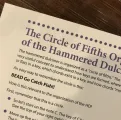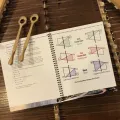The Complete Guide to Theory and Mapping for the Hammered Dulcimer
Choose "Paypal" at checkout to pay with either credit card OR Paypal, or call Ken Kolodner for assistance 410-746-8387.
Formerly known as: Chord Theory & Mapping for the Hammered Dulcimer, 4th Edition, this book has been significantly revised and expanded to over 100 pages!
This book summarizes a vast amount of material that is vital to a broad understanding of the layout, patterns, and chord theory that are foundational for playing the hammered dulcimer. The hammered dulcimer is in many ways unique as a visual/spatial instrument. We can significantly accelerate our mastery of the instrument via thorough knowledge of the patterns. Much like a guitarist uses chord patterns, we can do the same. This book focuses on the spatial nature of the hammered dulcimer with the purpose of gaining mastery of the organization of the instrument. The charts and diagrams are supported by brief discussions of supporting theory.
Spiral bound to support lots of use!! Over the last few years, we have worked to update the book by clarifying and expanding sections that folks found more difficult to understand. The updated book clarifies and greatly expands to 100+ pages.
All books are shipped via US Postal Service
What others say about this book:
"I kept waiting for the 'Oh..I can't read anymore! This is way beyond me!' I thought it would come at the Modes Chapter. I actually read thru that and 'GOT IT'....mostly! HA! The overwhelmed feeling never took over! They knocked it out of the ball park! Really folks....buy the book....you will learn so much and reinforce what you already know! Awesome!"
- Bob Flory
Review in the Nonsuch Dulcimer Players Newsletter by Peter Bromwich, October 2020
"This covers all the bases! It will be an invaluable resource--complete & concise."
- Susan Hartness
"Finally! A 'how to' dulcimer book that's really worth buying!
Since I started teaching in 2006, students have asked if there's a particular book from which I teach. The answer has been 'no'. I typically make my own handouts and information sheets based on the method from which I learned, i.e. the Ken Kolodner method. I am thrilled that Ken has recently put together a book that contains everything you need to know to master the hammered dulcimer. Those are BIG words, but seriously, there's a LOT in this book! This spiral-bound, easel-style book began as a collection of cheat sheets and charts to help students navigate the instrument. In subsequent editions, information and explanations were added to create a compact, easy-to-read summary of music theory for the hammered dulcimer. The information presented is essential to mastery of the instrument. Self-motivated players can work through this book on their own, although it might be helpful to have an experienced teacher give some guidance. If no such teacher is available (and even if there is) or if you simply want more "foundation" information to explore all of this on your own, check into Ken's "Big Bundle" on his website. That'll keep you busy for awhile :-)"
—Sue Wilson, published in "Trapezoids of the Triangle" blog, May 2018
If you'd like a guide to help you through this book,
click here to find out about Mary Lynn Michal's class offered through HD Homeland. She will guide you through the entire book from cover to cover in easy to understand bite-size bits: explaining concepts, demonstrating them on the dulcimer, suggesting exercises, and answering your questions.
For every concept, the book includes charts supplemented by a discussion page:
- Organization of the Hammered Dulcimer
- Shortcuts for Learning the Notes
- How to see and find intervals on the HD
- Circle of Fifths Organization of the HD – theory of circle of fifths and application to the HD
- Scales (4 patterns)
- Identification & Location of Duplicate Notes
- Additional Scale Exercises: octave scales, opposite direction, thirds scales
- The “Chromatic Trick” - finding chromatics
- Intervals
- Harmonic intervals - seeing 3rds, 4ths, 5ths, 6ths etc. - and extended intervals; octaves
- The “Rule of Nine” - application for chords
- Theory of Triads (major, minor & diminished) and Derivation of (Six) Three Note Chord Patterns
- Root Arpeggio Patterns
- Combining Arpeggio Patterns
- Inversion Patterns
- Moving Inversion Patterns
- Derivation of Three Note Chord Patterns
- Duplicate Three Note Chord Patterns
- Harmonizing a Major Scale with Triads
- Harmonization Exercises
- Harmonizing a Major Scale with the Most Likely Chord
- 7th Chord Theory and Patterns
- 7th Chords Overview
- 7th Chords (Key of D)
- Major 7th Chords
- Minor 7th Chords
- Dominant 7th Chords
- Dominant 7th Chords in Minor Keys
- Diminished 7th Chords
- 7th Chords Contain Two Thirds
- Comparison of Dominant & Diminished 7th Chords
- Full Range 7th Chords - combining chord patters
- Inverting 7th Chords
- Theory, use and patterns of Secondary Dominants
- Secondary Dominants (Key of D)
- Importing a Secondary Dominant
- The Secondary Dominant Pattern
- Developing The Chord Palette
- Additional Concepts Used to Develop a Chord Progression
- Relative minor
- Parallel minor
- Slash chords
- Suspensions
- Augmented chords
- The Chord Palette: Developing a Chord Progression
- Modes
- Backup
- The Compact Pattern
- Universal Backup
- Coda
Note for buyers of our previous book:
In the past, we offered free pdf versions of incremental upgrades as this book progressed from 9 pages up to 61 pages. These revisions (up to Edition 4) while significant, were relatively incremental compared to the new book. This was a generous offering because we wanted everyone to benefit from the improvements we were making in the book. This book represents a lifetime of Ken Kolodner’s unique contribution to the world of hammered dulcimer playing. Over time, we realized a much greater potential for the book. We have spent the last two years completely reworking the content and explanations for each chapter based on interactions with students. Mary Lynn Michal (van Deventer) is now a co-author and contributed significantly to the revisions. Mary Lynn teaches many Sandbridge students privately and helped revise problem areas. Together, with Laurie McCarriar, we added many concepts and new graphics to help clarify some of the more complicated aspects of music theory on the hammered dulcimer.
It has been an enormous amount of effort to produce this new complete guide and represents hundreds of hours for each of us. We hope that everyone appreciates just how much work has gone into making this book as comprehensive and helpful as possible. We apologize that it is simply not feasible to offer this as a free update.




